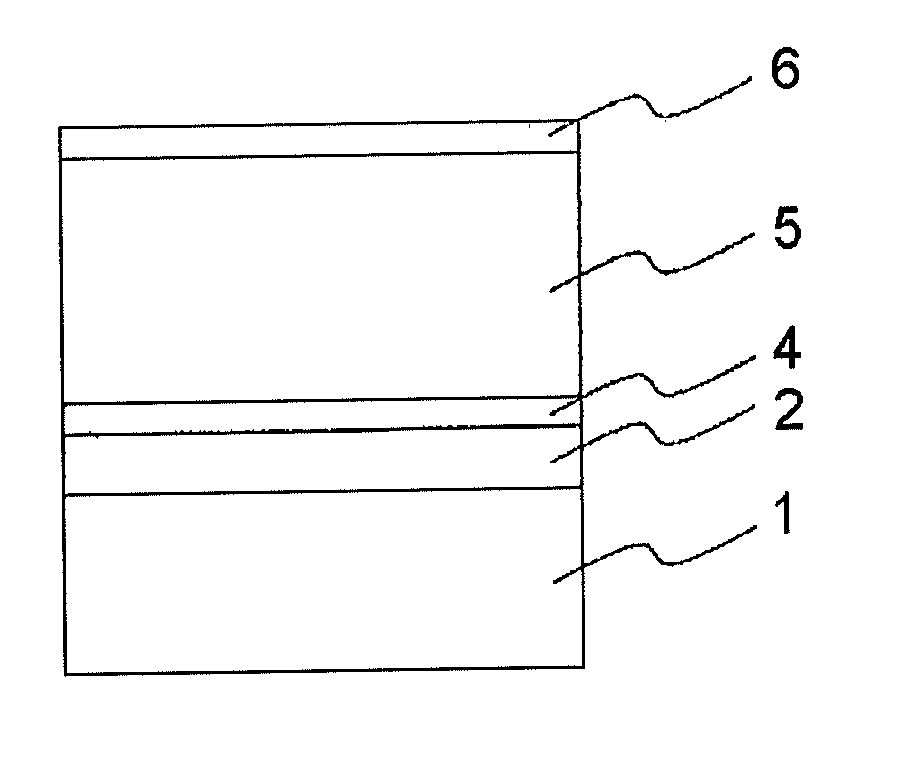Electrophotographic photoconductor and manufacturing method thereof
a photoconductor and electrophotography technology, applied in the direction of electrographic process, instruments, corona discharge, etc., can solve the problems of solvent cracking, large cracks on the photosensitive layer, and the use of bisphenol z polycarbonate as a resin binder in the electrophotographic photoconductor was problematic, so as to improve the cracking resistance of solvents, improve the lubricity, and improve the effect of lubrication
- Summary
- Abstract
- Description
- Claims
- Application Information
AI Technical Summary
Benefits of technology
Problems solved by technology
Method used
Image
Examples
manufacturing example 1
Method for Manufacturing a Copolymer Polyarylate Resin (III-1)
[0048]A 5-liter 4-necked flask was charged with 300 mL of deionized water, 1.24 g of NaOH, 0.459 g of p-tert-butyl phenol, 30.3 g of bisphenol A, and 0.272 g of tetrabutylammonium bromide. Further, 9.261 g of terephthalic acid chloride, 17.704 g of isophthalic acid chloride and 0.246 g of adipic acid chloride were dissolved in 300 mL of methylene chloride. The resulting solution was added over 2 minutes, and the reaction was left to proceed for 1.5 hours under stirring. Once the reaction was over, further 200 mL of methylene chloride were added for dilution. The aqueous phase was separated and was re-precipitated in four times the volume thereof of methanol. After drying at 60° C. for 2 hours, the obtained crude product was dissolved in methylene chloride to a 5% solution, and the resulting solution was washed with deionized water. The reaction liquid was re-precipitated by dripping while under vigorous stirring in 5 volu...
manufacturing example 2
Method for Manufacturing a Copolymer Polyarylate Resin (III-2)
[0050]The example was identical to Manufacturing example 1, except that herein the addition amount of terephthalic acid chloride was 13.346 g, and the addition amount of isophthalic acid chloride was 13.619 g. The polystyrene average molecular weight Mw of the obtained copolymer polyarylate resin (III-2) (23.2 g, yield 48.5%) was 70,200. The structural formula of the copolymer polyarylate resin (III-2) was as follows.
[0051]where l:m:n=49:50:1 (molar ratio).
manufacturing example 3
Method for Manufacturing a Copolymer Polyarylate Resin (III-3)
[0052]The example was identical to Manufacturing example 1, except that herein the addition amount of terephthalic acid chloride was 12.802 g, the addition amount of isophthalic acid chloride was 13.619 g, and the addition amount of adipic acid chloride was 0.737 g. The polystyrene average molecular weight Mw of the obtained copolymer polyarylate resin (III-3) (23.5 g, yield 49.2%) was 72,300. The structural formula of the copolymer polyarylate resin (III-3) was as follows.
[0053]where l:m:n=47:50:3 (molar ratio).
PUM
| Property | Measurement | Unit |
|---|---|---|
| Fraction | aaaaa | aaaaa |
| Fraction | aaaaa | aaaaa |
| Fraction | aaaaa | aaaaa |
Abstract
Description
Claims
Application Information
 Login to View More
Login to View More - R&D
- Intellectual Property
- Life Sciences
- Materials
- Tech Scout
- Unparalleled Data Quality
- Higher Quality Content
- 60% Fewer Hallucinations
Browse by: Latest US Patents, China's latest patents, Technical Efficacy Thesaurus, Application Domain, Technology Topic, Popular Technical Reports.
© 2025 PatSnap. All rights reserved.Legal|Privacy policy|Modern Slavery Act Transparency Statement|Sitemap|About US| Contact US: help@patsnap.com



